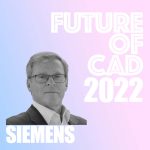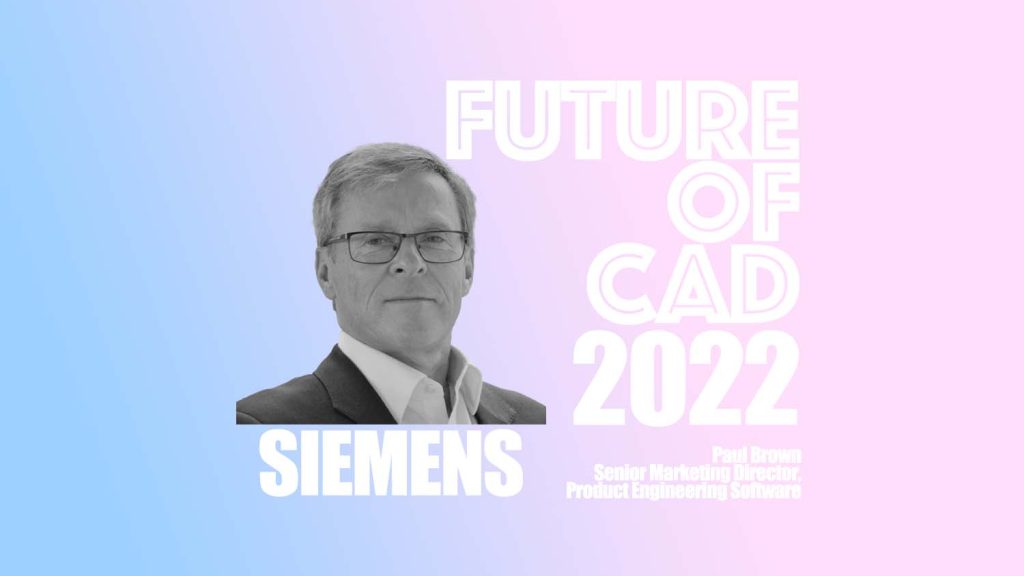 Future of CAD – Siemens
Future of CAD – Siemens
Time stands still for no-one – including design software, so we asked Paul Brown, Senior Marketing Director, Product Engineering Software, Siemens, for their opinions on the direction of CAD, ranging from initial concepting workflows, the impact of Artificial Intelligence (AI), and even how we keep it up to date
Q
How do you imagine sketch tool environments evolving?
There are two elements to sketching that a user deals with, one is the interaction model, the other is the intelligence (or lack of) that influences change and gives meaningful answers when a designer makes changes.
We see the biggest advantage coming from enhancing the engine that controls change, in software terms the solver, currently with most systems the user is expected to set up the constraints and rules that control behaviour, for example making two circles concentric or two lines parallel so they behave the way the user expects.
That is fine if the user can predict the changes they will make, but at the early stages of design that isn’t always easy. Then of course if your ideas change and you want to make unexpected changes you are then forced to locate and undo the rules that are controlling the behaviour of the sketch during edit.
At Siemens we have been employing AI to help remove the need for the user to predefine the rules and constraints, finding and implying them at the time of edit without forcing the user to do the work, this makes sketching far more flexible, and faster for doing initial design studies and concepts.
This approach allows people to think about what they want to create rather than trying to work battle with rules or constraints.
Q
How do you imagine designers will interact with CAD UIs in the future?
There are many different approaches to driving 3D CAD, but the mouse (and even touchscreens which mimic mouse) currently dominate. New approaches such as voice are beginning to break through, using voice and cognitive services allows you to drive CAD commands using natural language, freeing the user from having to speak CAD, being able to say “have I got anything similar?” instead of “shape search” for example makes it easier for users to get more from their systems.
In addition, the use of natural language means that things like standard parts can be described in company terms vs. CAD speak, if a company builds a template for connecting brackets using a phrase that is used in the organisation makes it easier, no searching for file names or icons. NX Voice Assistant uses Microsoft cognitive services to allow users to drive NX and increase productivity.
VR and AR are starting to have an impact on some workflows, this once again drives the user away from mouse usage and opens up more opportunities for visual UI that can be controlled by gesture.
While mouse and keyboard are going to be around for a long time, their use will be augmented by new approaches.
Q
Downloading regular updates to a 3D CAD package is more common – is this the way all 3D CAD is now heading?
Updating CAD systems must be a flexible process, while some companies can and do move quickly onto the latest update others need to fit upgrades into their product development programs. Users need the flexibility to decide what meets their business needs and how best to deploy releases.
However, we do see a drive to a continuous release process where regular updates and enhancements are more frequent. There are several benefits to this approach for a user, probably most importantly security, in todays connected world the threat to a company’s systems is greater than ever, component technologies that many software products rely on can bring security vulnerabilities that have to be constantly monitored and addressed.
It is a vendor’s responsibility to make sure their solutions are secure, and if any risks appear to quickly respond and nullify the risk, having a continuous release methodology means vendors can deliver secure software faster. Then of course there are new technologies, enhancements etc. once again having a process that delivers those quicker helps users get more value for their investment.
Continuous release is the only realistic way forward but done in a way that delivers flexibility for users to deploy when they can vs. forced deployment on a vendors schedule.
Q
How do you view the increase in AI impacting design tools the most?
The use of Machine Learning and Artificial Intelligence will have a massive impact on making it more productive for users to use CAD tools, having systems that can learn and promote best practice from power users and have that knowledge shared around an organization delivers massive benefits.
Having systems that adapt to both users and company needs was the focus for development in tools like the NX Adaptive User Interface with its command prediction capabilities, this helps users by offering predictions of the most often used next commands when they are in a sequence of functions. Expanding functionality with smart selection approaches that learn and recognise common geometric shapes etc.
The future for AI will see it expanding out to offer more help and advise users in design decisions acting as a support for choices in design. Areas like Generative Engineering opens more opportunities to use AI to help, advise and learn, doing rapid design iterations automatically, increasing use of AI in this area will help based tools helping engineers make better decisions faster.
Q
How do you imagine the users of your software will change and how do you see this impacting the software?
We are seeing a lot of changes in the engineering workforce, the increased use of electronics and software in products is meaning that today’s engineers must understand a multi-discipline environment.
Innovation is happening at the crossovers of mechanical, electrical and software and CAD solutions must support the new workflows that are critical to integrating the disciplines.
Tracing requirements and their impacts throughout the process, systems level engineering looking at the integration of the various solutions and that is forcing more integration between the traditional MCAD/ECAD and Software Engineering businesses.
Additionally new users are used to collaborating with friends and colleagues electronically, so building more collaboration tools into systems to support that need is important. That is fuelled by a greater acceptance of the cloud as a way of delivering greater connectivity. The cloud allows greater flexibility in access to technology, making it easier for engineers to get the tools they need and to share information. This will in turn change the way we look at applications used in product design.
Increased expectations on graphics both in performance and realism is becoming the norm, which once again is forcing traditional CAD systems to look at and adopt more advanced approaches to leveraging hardware.
Q
When will CAD software be able to take advantage of modern graphics APIs for better 3D performance and advanced features like GPU ray tracing?
At Siemens we are constantly looking at how we can enhance our performance of operations and graphics capabilities. We constantly evaluate new technologies as they evolve GPU processing, graphics API’s etc. and looks to see if they can truly help our customers by delivering higher levels of performance and display fidelity.
Siemens Digital Industries Software






